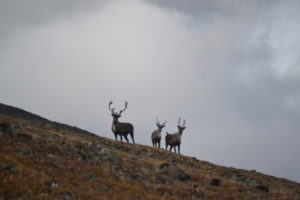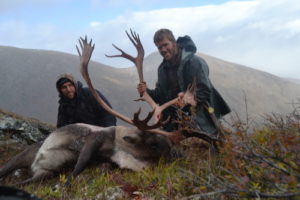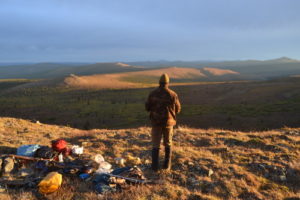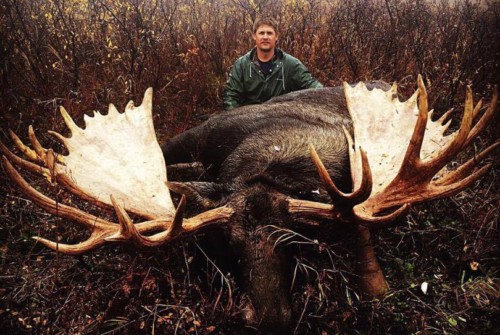‘A Few Hours Of Pain’
This story was originally written as part of the May 2015 issue of Alaska Sporting Journal.
Perfect Capper To Back-To-Back Dall Sheep Hunts? Pursuing Caribou, Of Course
BY BJORN DIHLE
I’ve been obsessed with caribou and the tundra, mountains and forests they inhabit for as long as I can remember.
The origin of the word “caribou” comes from Newfoundland’s Micmac, or Mi’kmaq, band. Rendered by French-Canadian into the word we know today, yalipu translates as “snow-shoveler”– caribou shovel through the snow with their sharp hooves to access lichens and other vegetation. Naturally, I took it as a good omen a few years back when my little brother Reid married a Newfoundlander, who happens to be a member of the Yalipu clan.
I suggested they honeymoon in the Arctic, perhaps follow a herd migrating from their winter grounds in the interior of Alaska to their calving grounds on the coastal plain. For some reason, they elected to go to Hawaii.
Lucky for me, I was born in Alaska, into a family that doesn’t know how to talk about much other than hunting, fishing and wildlife. In the spring of 2014 my older brother Luke came up with a grand plan of making back-to-back walk-in Dall sheep hunts and, if we had time, a caribou hunt as well.
Months before, while drinking beers and staring at maps, it seemed almost too easy. By the third beer, it didn’t even seem sporting. I suggested a handicap of some sorts – maybe attaching 15-pound weights to our ankles or something. Luke and Reid took a more irrational approach, consisting of exercising and eating healthfully. When they encouraged me to do the same, I laughed.
“Look at the toughest guys in America: Russell Crowe, Denzel Washington and Liam Neeson. Do any of those guys train? I doubt it. They just go into a room and beat up a dozen or so armed jerks half their age. Neeson once trekked across the frozen Arctic in blue jeans, fist-fighting demon wolves the entire way with zero training,” I argued.
They said something about how movies and real life were different, but it was too philosophical and went over my head.

IN EARLY SEPTEMBER, we’d made two sheep odysseys, covering more than a 120 miles through some of the most beautiful mountain country in the world. At the end of the second hunt, we still had a few days before we had to return home. We left our sheep meat in a friend’s freezer in Tok and drove north into Fortymile country; caribou season opened the next day.
Willows and aspens blazed yellow and red. Valleys were filled with the smell of fermenting cranberries. Snow crept down ancient shale-covered mountains. Reid and Luke shouldered their packs and followed a faint four-wheeler trail into desolate rolling hills. There was none of the excitement I generally felt at the beginning of a hunt. I limped behind, fighting the desire to lie down in the mud and take a nap.
“You sure you guys want to do this?” I asked when I caught up. In reply, they grumbled like constipated brown bears just awoken from hibernation.
I moped along, considering adding a little something extra special to Luke’s dinner that night – maybe some caribou pellets or bear poop. Three walk-in hunts with no rest in between had been his idea, after all. Maybe I could find some centipedes.
Luke gestured toward the hill. “Years ago, I met an old-timer resting there. His head was down and he had a load of meat on his back. He looked utterly spent. I asked if he was all right and he just smiled; he kind of had a twinkle in his eye, saying something about how a few hours of pain for a winter of good eating was a good deal.”
I pushed away my evil scheming and instead recited the mantra “a few hours of pain for a winter of good eating” as we hiked through a forest burnt to charcoal from one of the area’s many forest fires. We crossed a tussock field, gained access to an alpine ridge and climbed a scree-covered mountain. At the summit, the bleached antler shed of a large bull lay like a religious icon beneath the cold gray sky.
That evening we sat around camp, eating instant mashed potatoes and hot dogs. We’d been snowed on a few times during the last sheep hunt, but as the sun set the weather looked about as nice as it could get for September in the Interior. Shadows swept across valleys, the sun bathed the hills in golden light, and distant snow-covered mountains jutted like a carnivore’s teeth into the blue horizon.
We talked of caribou and how lucky we were to be in their country, and able to hunt them. Though we were all meat hunters, Luke wanted a wallhanger and claimed he was going to pass on any small bulls for at least the first day. Reid was hoping for a freezer trophy: a young, tender, delicious bull. I was resolved to act only as a meatpacker – my freezer was already getting pretty full with fresh salmon, venison and a sheep.

“CARIBOU!” REID HISSED.
My brothers quivered as a herd of a dozen massive bulls filed through the yellow, willow-covered valley below. A couple had bloody strips of velvet hanging from their 3-foot-high splayed antlers. A group of cows and calves climbed towards a plateau. All moved steadily to the northwest –they could be 30 miles away by the following morning.
A couple years ago when I last made a Forty-mile hunt, we’d hunted hard for days and only encountered a few caribou. Luke took a nice meat bull on the second to last day, while my girlfriend and I – 13 miles from the road – lucked out and got a bull with just a few hours left during the last day of the hunt. An adult bull yields around 100 pounds of meat, which made for a long and relatively brutal pack out.
Before dawn, I awoke to the eerie, beautiful howling of a wolf from the valley. Its wild and plaintive beckoning went unanswered. Soon after the wind picked up and snow began hissing against the nylon walls of our tents. Luke and I crawled out into a blizzard just before dawn.
We turned our backs to the weather, boiled a quick cup of tea and set off in the direction the caribou had been moving the night before. Shortly thereafter, we were engulfed in a white-out and platered in wet snow. We could have been walking by whole herds. We were following a network of caribou trails through the gray when Luke fell to a crouch. Kneeling on a snowy tussock, I stared over his shoulder and saw a group of young bulls, well within range, moving parallel to us through the storm. They were all perfect, the sort of animals I prefer harvesting for maximum taste and tenderness, but there were no massive bulls. A male caribou usually reaches sexual maturity around 6 or 7 years old, which is no small feat considering that everything loves eating them. One bull was larger than the rest; Luke looked back at me and asked in a whisper what I thought.

“You’ve wanted a caribou rack for the wall for a long time,” I said.
“This is so weird,” Luke said. “I’ve never passed on an animal like that.” We trudged on in the direction where the big bulls had been heading the night before. A herd of cows and calves wended in and out of willow thickets in the valley below as the weather cleared.
We clambered up to the top of a plateau where the icy wind blew fiercely. Shale-covered mountains dusted with snow rose to the west and the north. Any other species would seek cover, but not caribou. The colder the weather, the happier they seem. A herd of two dozen milled on a nearby plateau.
Luke and I descended until we were out of sight and then used a series of ravines to make a stalk. With our hearts thundering, we peered over the edge and studied cows, calves and subadult bulls. We moved on, taking time to glass each bowl and valley. Caribou would emerge from the tundra and mountains like magic, but none were adult bulls. We even crept down on three that were sleeping and nestled in beds on a mountainside.
IN THE EARLY afternoon we sat in a barren saddle 12 miles from where we’d left the truck. This area had always been good to us during past hunts, but both of us were questioning the rationale behind hauling a bull so far from the road, especially when we’d encountered the herd of subadult males near camp. Luke was second-guessing his decision not to shoot when I saw the red flash of antlers in the willows a half-mile away.
“There’s your animal,” I said, squinting through my scope. Amidst a dozen calves and subadults, two adult bulls fed and thrashed through a willow thicket. We clambered down a steep ravine for coverage. Luke tumbled and smashed his left hand. His trigger finger swelled up so badly we wondered it was broken. He shook it off and kept going. By the time we got within view of the herd they were moving away, up into the mountains.

“Looks like they’re gone,” Luke said.
“Leave your pack with me,” I said. “I bet you can get within range.”
Witnessing Luke making a stalk is a bit like watching the elk-hunting scene in The Last of the Mohicans. I have trouble walking up a mountain, but Luke is able to run without breaking a sweat. In a blizzard, he disappeared out of view, taking a direction he hoped would allow him to cut the herd off. By the time he was at the same elevation, I was feeling a little bad for encouraging him on a wild-caribou chase.
He belly-crawled through snow to the draw he was hoping the animals were following; I waved my jacket over my head and signaled the caribou were further away. By now the herd knew something was up and the alpha cow was steadily leading the rest higher up the mountain.
A moment later, a flock of ptarmigan, already in their white winter plumage, exploded into flight at the hooves of the cow. Startled, she ran in the opposite direction, towards Luke. The two big bulls, twice the size of every other caribou, followed. When Luke saw antlers bobbing against the horizon, he stripped off his shirt for a rifle rest. My first thought was, “damn, he’s even whiter than a halibut’s belly,” but as minutes elapsed, I began wondering how long it was possible to lie half-naked in a blizzard without becoming hypothermic. At the crack of the shot, one of the bulls keeled over. Twenty minutes later, sweating and out of breath, I climbed to the bench where Luke sat shivering next to a magnificent caribou. I passed him a couple jackets and gradually he warmed up.
“What a beautiful animal,” I said as I rested my hand on its warm body. For more than half a decade, the bull had wandered the Interior wilderness, hunted by wolves and people. He’d survived weeks of minus-60 temperatures during the winters and hordes of biting insects during the summer. He was an expression of the land itself.
He was perfect.
“THANK YOU, GOD; thank you, caribou,” Luke said. We butchered and began the long haul out. Late in the day, we encountered Reid hiking across a tussock field. He relieved us of a significant amount of meat and, together, we busted through a valley of willows and climbed up to the top of a plateau. Still 6 miles from the road and without enough time to get out before dark, we buried the meat in a rockpile.
We sat nearby, enjoying a peaceful evening and the pleasant scenery. Reid regaled us with a story of a bull moose he’d encountered; it had antlers wide enough to lie down in. Moose season opened the next day. Thankfully, none of us had a tag.
“This couldn’t get any better,” Reid said, watching the sun glow on the tundra.
“Yeah. Unless that young bull you were hoping to get ran by right now,” Luke said. Less than a minute later, the clacking of tendons and thunder of hooves startled us.
“You got to be kidding,” I said as three young bulls stopped 40 yards away and stared. Luke and I began laughing, but Reid was all business. He grabbed his rifle and in a few seconds assured that he’d have delicious eating for the year to come.
“He’s exactly what I was hoping for,” said Reid, kneeling over the caribou. We gutted him, then broke his brisket and pelvis, propping open the rib cage with a stick so he would cool quickly.
After covering the caribou in spruce boughs, we hiked across the darkening tundra towards camp. Scattered groups of caribou slowly came in and out of view along ridges and plateaus. That night we feasted on heart and instant mashed potatoes. Tomorrow would be a brutal pack out, but what’s a few hours of pain for a winter of good eating? ASJ




